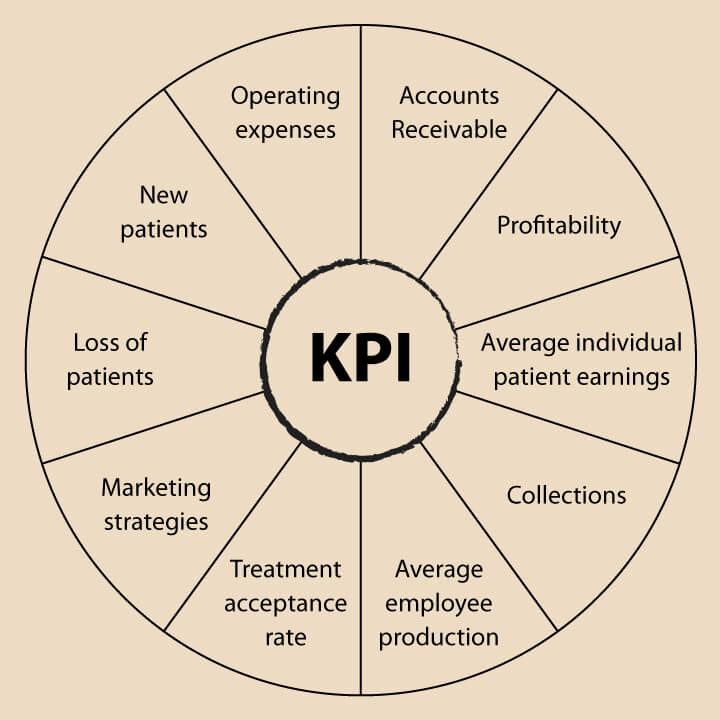Ends in
ends in 127 Days

ends in 127 Days

ends 11 July
22 Key Performance Indicators of a Dental Practice

Telephone, telegraph, tell a dentist—while this may be one of the cheapest forms of advertising, it isn’t the best. Many offices want to rely on cold, hard numbers, in other words, their key performance indicators, or KPIs, to ensure they are operating at a level they consider a success.
You can be an outstanding practice owner or oral surgeon and still question why your practice isn’t growing. If you noticed that a clinic down the street has expanded its reach by leaps and bounds, it's time to start tracking your KPIs.
What Are Key Performance Indicators?

KPIs are monitored at different times throughout the year, many times by office managers. Each office will have about 15-20 KPIs that reveal key details about operations, profitability, performance, and other critical data points. While it’s not imperative to hit every KPI, it's essential to focus on the ones that will help grow your practice and improve your business strategies.
Why Are KPIs Important?
If you’re an office that is in the habit of regularly monitoring your KPIs, you probably know these metrics reveal how you’re performing. If you're using analytical software built into your PMS, you can enjoy an almost real-time review of practice health and performance. Past trends will also be equally important, so you can pinpoint data that highlights your strengths and weaknesses.
Whether you know it or not, if you are operating your business without the benefit of KPIs, you are not performing at the top of your game!
Top Dental KPIs You Should Be Measuring

Below are the several KPI categories you and your team should consistently monitor:
- Accounts Receivable
- Profitability
- Collections
- Average individual patient earnings
- Average employee production
- Treatment acceptance rate
- Marketing strategies
- Loss of patients
- New patients
- Operating expenses
As you can see, this data generates a fairly clear snapshot of how your practice operates, patient trends, and so much more. However, there are at least 22 KPIs that should be on your radar.
Let's take a quick look at each one!
1. Practice Production
Practice production is on every dentist's watch list. It's easy to recognize when your office has been busy versus sluggish-- which might set off alarm bells. If you've noticed an increase in production per patient for the month, your profits plateauing will have you instantly questioning where the money went. This can lead to even the most chill practitioner panicking.
Keeping track of production metrics is of the utmost importance, but it's just a snapshot of the panorama that is your dental office. This high-level metric measures what your practice is doing both day-to-day and throughout the year. However, practice production should be the river that feeds the ocean and guide you to potential bottlenecks in the flow of things, which are holding back profitability.
2. Overhead
Overhead eats into profits as quickly as a cavity eats into a tooth. Unfortunately, the dental industry has what is known as the highest overhead in the business. In dentistry, a middle-of-the-road estimate has hovered around 74% for several years now, though this number depends upon your specialty or offers multiple. Unfortunately, patients don't have a clue about this reality and will try bargaining with their dentist for cheaper services as if on “Let’s Make a Deal”!
While overhead can be broken into direct and indirect, at the end of the day, the combined total can be staggering.
123 Dental strengthens patient communication and raises confirmations 20% with Adit Tired of second-guessing your daily schedule? When multiple disconnected systems created missed calls, chaotic scheduling, and slow reviews,...
Schedule a DemoWhat does overhead entail?
- Salaries
- Rental spaces
- Equipment
- Supplies
- Utilities
- Internet
- Other various needs
There are things you can do to lower your out-of-pocket costs, such as negotiating the price for your rental space, purchasing ‘new to you’ equipment, or other cost-cutting measures. Regardless, keep a close eye on your costs, whether negotiated down or not.
3. Accounts Receivable
Without starting the dental mafia, you have to be aware of how your outstanding accounts. Not being paid on a regular schedule can cause your practice to deteriorate under your feet and be quietly killing your office.
Tracking this metric can help you better understand what's going on with your collection process if you can't hit 95% collected each month. Many times it's just a matter of convenience and needing payment flexibility that has patients going from slow pay to early bird. Also, a modern billing integration that can pre-check insurance and automate the coding process can avoid claim denials.
4. Average Production Per Patient
Also known as Annual Patient Value (APV), this metric helps you measure how much revenue each of your patients brings to your dental clinic. When on the low side, this is a red flag that you and your team need to be doing more to encourage acceptance of additional services and possibly bring your costs down to attract prospects.
Another issue you might notice is that you're office is treating a significant number of patients but the amount they're spending is too low. This might be a sign that your dental team needs to allow slightly longer appointment times so they can better connect with patients, creating more opportunities for additional care.
Your goal is to have new patients with higher numbers than those you see annually since they often require more dental care when first being seen.
5. Average Production Per New Patient
As mentioned earlier, new patients often have a higher APV rate than those who are established. When first visiting your office, they often need to "catch up" on dental care because they've neglected their oral health for some time.
Other care opportunities you'll potentially have that contribute to new patient production numbers include:
- Extensive treatment opportunities because of your service level options
- Diagnosis of more serious conditions
- Greater urgency because of no access to dental care
- Getting a fresh perspective on an oral healthcare issue
There's an additional opportunity that this metric could reveal: bringing in their family members. As you can see, new patients can easily bring in double or triple the average production of a regular patient.
6. Active Patient Count
The active patient count is one of the top-tier ways of measuring the growth of your office. Although it can differ from place to place the window for classifying a patient as active is usually about 12 - 18 months. Remember, an active patient count is representative of organic growth instead of artificially increased numbers.
For example, if the last two months of work were extremely profitable, and you were only tracking salaries, procedures, and similar metrics, you might predict a strong upcoming quarter. But on the flip side of this coin, if your active patient count drops and continues this downward trend month after month, you may find yourself in deep water. Why? Because you have been using things like emergency procedures to offset your profits for the short term.
7. Practice Profit
Your profits are key pieces to the puzzle, but there’s a reason it’s different from other KPIs and worth tracking. After subtracting the cost of labor and materials, you can calculate what percentage a procedure costs. That means if 76% of your revenue from dental implants goes to cover your overhead, you’ll be aware of the monetary loss if you accept a lower-paying insurance carrier.
8. Scheduling & Time Allotted
Tracking time can create tension in your office, but it’s crucial if you want to ensure you're running a tight ship. As for KPIs, the significant thing to remember is to allocate the appropriate amount of time for patient visits. Team members need time to get to your office, prepare for procedures [which can add another 15 minutes if anesthesia is necessary), perform the procedure or surgery, and finally, follow up with the patient.
This KPI can be the metric that helps you figure out how you can boost efficiency and keep no-shows to a minimum with automated reminder processes. If a patient continues to be a kink in the chain of your well-oiled machine by being late or canceling last minute, despite being accommodating, you may need to eliminate them from your roster.
9. Case Acceptance Rates

Many clinics struggle with case acceptance rates, with little over 50% of established patients committing to treatment and less than 30% of new patients agreeing to be treated. A huge roadblock to case acceptance is a lack of trust between dental providers and their patients, including inadequate communication between the two.
If you're noticing this metric taking a dive, it's a great signal that communication and education need to improve. When patients understand why a procedure is crucial to their oral health, this number rises.
10. Dentist and Hygienist Production
With the average daily production average for dentists at around $440/hour or $3500/day, if your practice reaches this admirable goal, you are running an efficient business. But to see a true number that represents how you are doing, take your day-to-day production from your daily overhead.
Throughout the year, you should review production by provider in your practice. Your hygienists and dentists should be able to achieve goals set on a daily, monthly, and yearly basis to reach a 5 to 10% increase.
11. Office Admin Production
Office admins are undoubtedly the backbone of your practice. They are the front line and face of your business. Unfortunately, it can be challenging to know the sweet spot number of how many team members you need versus the patient load.
An excellent metric is to have one admin for every 50k-60k a month, then for every 25k you gain, add a team member. Or, measure their workload by headcount. If your office sees about 21 people a day, then one person in the office admin position could probably handle that traffic.
12. Cancellations & No Show

This KPI, maybe more than any other one, can be a painful pressure point for clinics. Lots of offices operate on optimism, which is always a great thing. But, they also need to be realists when no-shows and cancellations are a consistent problem.
Clinics should track these metrics to account for your daily bookings and production time. It also signals you need to create a strategy to mitigate this threat to your revenue. Maybe you just need to improve your reminder and scheduling process with a more automated approach. Or, you might also need to start enforcing fees as a consequence for repeat offenders.
13. Recare
It can be quite astonishing to discover that most offices don’t track recare since they never really implemented a strategy for it. Recare is imperative when your average patient only gets dental care about once a year.
Amazingly, a recall system where patients receive automated reminders to schedule or attend an upcoming appointment can be the factor that reduces the number of inactive in your database. In today’s technologically driven society, it's simple to set up and persuade existing patients to come back for treatment if using the right practice management tools.
14. Number of New Patients a Month
This metric is a popular KPI because it shows whether your office prioritizes gaining new patients. However, there is a myth among dentists that the number of new patients you bring in will be the factor that makes or breaks your practice. The truth is that for most offices, it's the number of returning patients that will cause a dentist to thrive or not.
In Vegas, a gamble may be a good thing, but in your dental chair, it is not. That’s why new patients aren’t always the boon to profits they are made out to be. It can be unclear what payment habits they have, what kind of insurance they carry, or how much time the clinician will have to spend with them. Instead, you need to tie this number to your gross profits so that you can assess whether or not that avenue should be the one to focus your energy on.
15. Patient Attrition
Do you have any idea how many new patients have transitioned into returning patients over the past year and a half? If you can't, you aren't alone. This metric is critical to identify where you are hemorrhaging patients and what impact this loss has on your profitability. If you research and find that this isn't the case, and patient loss is not affecting your clinic, you’re running an efficient office.
On the flip side, if you're seeing a substantial loss of patients, it might be time to rethink parts of your practice. A couple of things you can do that have a remarkable return on investment is nurturing trust by building stronger doctor-patient relationships.
16. Employee Wages
Getting to a point where you have to dismiss an office member who feels like family because you can no longer afford them is awkward and heartbreaking. The crazy thing is many offices still hand out raises and bonuses to their staff even when they haven't increased their profit margin or have accounted for market rates. Be careful how high your wage overhead gets. If you are going higher, you may need to take a deep dive into your business strategy.
17. Total Procedures Performed
Would you like to immediately understand how your production is rolling along and how to reproduce the success you’ve already had? If so, this KPI can do that for you!
With just a quick peek at this metric, you should be able to see:
- Number of completed procedures
- Revenue earned
- Days with low procedure volumes
- Periods high in revenue
- What led to your ROI
- Practice efficiency
- If you have a high volume of procedures but low revenue
18. Production by Procedures
While knowing the number of total procedures you do is meaningful, it's equally important to know the earnings and volume of those performed individually.
For some dentists, this information reveals their overall practice strategy at work. For example, this metric can also help your team pinpoint which insurances are most often used and if the service model is working for the market you're trying to attract. You might consider eliminating or renewing focus on certain procedures to improve their profitability.
19. Insurance Production
Often dental offices don't include insurance costs as part of their overhead, but it might be worth pulling this KPI to the side and looking at it closely. It provides an analysis of not only the types of insurance your clients have but whether their carriers are offering fair negotiated rates or hurting your bottom line.
It's becoming more commonplace for practices to operate on a fee-for-service basis. Still, you won’t know if that is the most profitable route for your own dental office if you don’t track this metric.
20. Fee-for-Service
Using KPIs for tracking elective treatments and fee-for-service production can help you identify what procedures have produced the most revenue for your office. With this data, you can identify service offerings that simply might need more marketing or upselling. It's also a great way to improve case presentation to patients so they are likely to accept your recommendations.
Help your patients understand, in easy-to-comprehend terms, the price and value you are offering. Tracking this metric can help you to analyze what works for your practice and what doesn’t.
21. Clinical Days Worked
This KPI applies to everyone in the office, from the upper echelons of dental surgeons, specialists, and dentists, to the backbone of any office, the hygienists. Tracking who worked, the days they worked, and the procedures they performed can give you insight into fitting more of the puzzle pieces of your office together.
For example, if you find a trend of specific days that are consistently slow over the years, you can decide which days of the week and what hours your office should be open. You may even find virtual consultations are better on these slow days.
22. Retention & Turnover
Have you ever wondered why it seems, from time to time, lots of people are jumping ship and leaving your practice? On the other hand, have you ever had the enviable situation of wondering what keeps someone around for a long time? Using KPIs to measure turnover can help you understand the answers to these questions.
An example of how to best use this information is to figure out if it's more cost-efficient to have one full-time hygienist or two who are part-time to balance the workload more efficiently. If you’ve noticed that you're experiencing employee turnover at a higher rate than average every six months, you might consider restructuring your team to increase retention.
Interpreting What Your Dental KPIs Mean for Your Business

If your staff is on top of their game, maintains detailed records, and you have solid practice management software, then the job of gathering data for your KPIs is practically done. Begin with the data from three months prior, then move on to analyzing the information on average production each day, new clients per day, collections, staff expenses, and last but certainly not least, daily overhead.
An astute office manager should be able to look at these numbers and tell immediately where and how your practice may need improvement. An example of this is in collections. Your collection numbers should show that most of your clients are paying on time. If your clinic is highly effective at billing and collecting, you’ll have a success rate of about 98.5%. If your collection rate is below this mark, you might want to consider improving your strategy in this area.
Being busy as a bee doesn’t always equate to a topped-off bank account, unfortunately. Take the KPI for average production for patients for example. This metric will gauge how much your office receives for the services they provide for each patient per day. A patient receiving only minimal treatment services at around $150 a visit is not as profitable as a patient who wishes to have high-end treatments valued at $400 or more.
By doing the math, you’ll see that having more patients doesn’t necessarily equal more profits, but a higher average production per patient will. Many dentists find boosting those daily averages alone provides a noticeable jump in yearly revenue.
The ability to take this data and turn it into actionable insights can be a tricky process without the right tools. If your practice management software doesn't include analytical features that translate this information intuitively, consider integrating a platform that does.
What Features Should Your Dental Practice Analytics Software Offer?

I am sure by now, it’s obvious that different KPIs can give you the pinpoints needed to be a highly successful dental service provider. Using this information, you can create a strategy that keeps you in front of potential workflow issues in your practice.
One challenge in measuring KPIs is ensuring the data you receive is accurate and unbiased. You need to make well-informed decisions based on this information and using outdated software can leave you with blind spots.
Who can benefit from practice management software that tracks and analyzes business metrics?
- Solo dentists
- DSO members
- Multi-branch practice owners
Keep the following five factors in mind when you are deciding which platform is best for your office:
1. Capabilities
Functionality is one of the primary benefits of practice management software (PMS). It should strengthen patient experiences and improve treatment outcomes along with a whole host of other features, including:
- HIPAA-compliant communications and EHR/PHI storage
- Cloud-based hosting for increased accessibility
- Real-time, online scheduling
- Streamlining of operational workflows
- Digital X-rays and clinical charting
- Automated appointment confirmations and reminders
- Automated billing and payment
- Centralized communications
If your office is specialized, look for a PMS with features specific to your area of practice. Don’t forget to include other patient needs, such as supportive filing features for procedures that are medically-based dental treatment.
You don’t want to get stuck with management software that will require a complete overhaul in a few years, either. Scalability is essential when choosing a state-of-the-art platform to streamline and future-proof your office.
2. Metric Tracking
Don't leave tracking KPIs on the back burner until your office has a figurative five-alarm fire. Customizable data analytic features in your PMS can keep track of crucial metrics that directly affect the success of your clinic, such as:
- Treatment compliance
- Case Acceptance
- Patient retention and recall
- Billing and collections
- Team productivity
You won’t need a crystal ball to see the future if you keep on top of your KPI numbers. Luckily, dental practice management software like Adit makes this process easy with AI algorithms and automated processes for reporting.
3. Seamless Integrations
So you say you are already happy with the dental management software you use, but you'd like to add some special features? Adit may be the choice for you because it offers products that mesh seamlessly with other popular systems. Rather than integrate an entirely new system that will cause major disruption to your operations and patients, you may just need to integrate a new module, like Adit Pay, a digital billing and payment tool.
4. Top-Notch Product Support
Ideally, any management platform utilized in your busy dental clinic should provide continual product support and updates for as long as you use the software. You're going to need more than installation assistance. Any PMS vendor you partner with needs to provide world-class customer support to get the most out of your new system.
5. Dedicated Training
Because of its built-in intuitive nature, cloud-based software is usually easier to onboard. But the whole purpose of your office switching platforms or integrating new features is to create a more streamlined business.
Practice management software has a learning curve, even if you're just integrating a new feature into your existing system. Choose a product that provides comprehensive training at a pace that supports your team's workload. This will ensure no one gets overwhelmed learning the new software.
The Best Dental Practice Analytics Software

Make sure you take a tech-forward approach to manage your dental business and not let obsolete software hold you back. You want the best metrics and digital analytical tools to let you know how much revenue your company generates from many different areas. Adit helps you expeditiously access the most important KPIs like:
- Production per visit data
- Acceptance rates
- Claims and collections
- Patient follow-up care
- Performance dashboards
- Revenue
- And more!
Adit can be a trusted partner and support team to help with your KPI analysis. Adit knows how to take this data and leverage the insights gathered to create a thriving clinic. Our developers constantly work to provide top-notch technology and automated features that will give you the quality metrics you need to develop the dental office of your dreams!
Go online or call us today to schedule your free demo and learn more about our platform and how it could fill all your dental needs!
more about Adit?
Access a full suite of patient communication tools with Adit! Texting, payments, reviews, & scheduling in one place.
Schedule a DemoAngela is a former English teacher turned marketing content specialist. Over the past 10 years, she’s developed marketing strategies to forge enduring bonds between B2B, B2C and SaaS companies and their clients through holistic education, effective communication, and captivating storytelling that moves audiences to act.
Get a $25 Gift Card when you take a demo
Schedule a Demo
Get a $50 Gift Card
when you take a demo
Looks like you're out of bounds!
Hey there! Your current location falls outside Adit's area of operation. If this is unexpected, try disabling your VPN and refresh your page. For further assistance or to book a live demo, connect with us at 832-225-8865.
January 7 Amazon Demo Promo
Terms and Conditions
Last Updated: January 7, 2026Offer ends January 10, 2026, and is limited to prospective customers who sign an annual agreement before January 31, 2026. Gift card will be emailed to the company owner or established representative within 4 weeks of signing the annual agreement. Offer may not be combined with any other offers and is limited to one (1) gift card per office. Offer is not available to current customers or to prospective customers or individuals that have participated in a Adit demo during the prior six (6) months. Recipient is responsible for all taxes and fees associated with receipt and/or use of the gift card as well as reporting the receipt of the gift card as required under applicable federal and state laws. Adit is not responsible for and will not replace the gift card if it is lost or damaged, is not used within any applicable timeframe, or is misused by the recipient. Adit is not responsible for any injury or damage to persons or property which may be caused, directly or indirectly, in whole or in part, from the recipient’s participation in the promotion or receipt or use of the gift card. Recipient agrees to indemnify, defend and hold harmless Adit from and against any and all claims, expenses, and liabilities (including reasonable attorney’s fees) arising out of or relating to a recipient’s participation in the promotion and/or recipient’s acceptance, use or misuse of the gift card. This offer is sponsored by Adit Communications, Inc. and is in no way sponsored, endorsed or administered by, or associated with Amazon.
Thank You!
We appreciate your interest! Adit AI will be calling you in the next few minutes!
Why Adit?
Cut your software bill by up to 60% when you merge everything your dental office needs to run under one roof.
Centralize Communications
- Phones & TeleMed
- Emails & eFax
- Texting & Reminders
- Call Tracking and more!
Streamline Operations
- Patient Forms
- Online Scheduling
- Payments
- Reviews and more!
Boost Production
- Performance Dashboards
- Morning Huddle
- Claims & Collections
- Patient Profiles
- Follow Up Lists
- Year Over Year Metrics
Acquire More Patients
- Digital Marketing
- Website Design
- SEO
- Google Ads
- Facebook Ads
Ends in

and Get Free Phones for Life
Sign up by filling out the form







